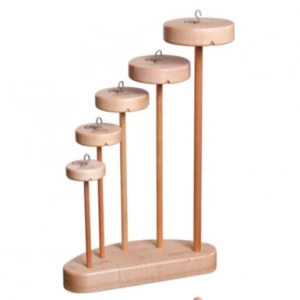Science of a Drop Spindle
Interested in spinning, but no room fora spinning wheel, not sure you want to commit to a hobby that takes up too much space? Have you thought about the drop spindle?

The pre-curser to the spinning wheel, drop spindle are great way to make your own yarn. They travel well, simple to use and have hundreds of different options.
There are many different kinds of drop spindles in the world and they all handle a little bit differently. You’ll need to try a few before you’re sure to find what you love, but here is some of the science behind what you should know when you look.
A Quick Breakdown of the Science of a Drop Spindle: Mass, Balance, Shape, Mass Distribution, Yarn and the Human Element
Mass: the heavier a spindle is the more energy it take to start it in motion, so a 10oz spindle takes 10oz to get it moving, but likewise 10oz of force has to be applied to stop it. This makes it so that the lighter spindles will slow faster than heavier spindles.
Heavier the spindle the more force it takes to start and stop- the longer you can spin without adding force by flicking it or Greater mass = greater momentum

Balance: Spindles need to have balance so they maintain the energy as long as possible. This doesn’t mean that a spindle has to be round but rather that the weight is evenly distributed around the axis or the shaft when turning. You could spin with a square whorl on your spindle or even with a single glass bead like the Romans did.
Shape: How you hold it, affects how you use it. Shape changes where you grab, how you add energy flick your spindle or make it work. It also is an element of Mass Distribution…
Mass Distribution: how the spindle is shaped, where the weight/mass is affects how it works.
Low whorl spindles are less likely to be affected by outside forces like wind. The mass is closer to the ground and gravity is helping to keep the balance of the spindle, so it can keep rotating on a single point. Low whorl= less wobble which leads to rapid slowdown, a low whorl is more forgiving to flaws in the structure of the spindle, such as warp in the woods or a less balanced weight in the whorl.
Mass Distribution how the whorls shaped in proportion to the shaft affects its speed. The closer the weight is to the shaft the faster it will spin, the fast the twist will move into the yarn, the faster the resistance is created in the yarn, the sooner the spindle will stop because of the twist built up in the fiber. Wider whorls spin slower creating twist slower.
Yarn: the yarn that your spinning affects your spindle as it is loaded onto the shaft the weight, balance of energy, and the shape all change. The fiber that you’re making the yarn also changes how the spindle reacts. Drop spindles work best with longer staple fibers, for beginners the shorter the staple the more times you’re picking your spindle off the floor. Furthermore, if you are spinning a super thick single on a drop spindle the fiber is handled differently than a lace weight, you might need a different spindle for different projects.

You- the Human Element: no person handles a spindle in the same way, more likely than not, you don’t handle your spindle the same way every time. How do you like to set your spindle into motion? How do you like to handle it? Where do you like to spin? What do you feel like looking at today? The perfectly balanced mathematically sound spindle could be given to you and you can hate it because it’s ugly, or because it’s too big. If you’re choosing a spindle pick some that you like then try them, you might be surprised with what you like. You shouldn’t spin fiber you hate and you shouldn’t have to look at something ugly.
Interested in everything and anything on the drop spindle check out the book; Respect the Spindle by Abby Franquemont or the DVD
